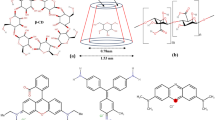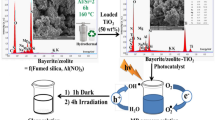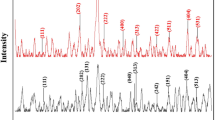Abstract
The present work targets to develop the cross-linked chitosan composite with different TiO2 phases (Degussa/Anatase) to attain two adsorbents namely cross-linked chitosan-epichlorohydrin/TiO2-Degussa (CS-ECH/TiO2-D) and cross-linked chitosan-epichlorohydrin/TiO2-Anatase (CS-ECH/TiO2-A). The physicochemical characteristics including crystalline nature, specific surface area, functional groups, surface morphology, and thermal stability of the prepared composites were identified by X-ray diffraction (XRD), Brunauer–Emmett–Teller (BET), Fourier transform infrared (FTIR), scanning electron microscope (SEM), and thermogravimetric and derivative thermogravimetric analyses (TGA-DTG), respectively. Response surface methodology combined with Box–Behnken design (RSM-BBD) was used to explore multivariate modeling and optimization of reactive red 4 (RR4) dye removal on CS-ECH/TiO2-D and CS-ECH/TiO2-A based on the related factors including A: adsorbent dose (0.5–1.5 g/100 mL), B: pH (4–10), and C: time (30–90 min). RR4 dye removal was 94.6 and 87.5% for CS-ECH/TiO2-D and CS-ECH/TiO2-A, respectively. The adsorption of RR4 molecules on the surface of CS-ECH/TiO2-(D/A) was constructed by many interactions e.g. electrostatic forces, n−π stacking, and H-bonding. The findings revealed that the biomaterials developed could be viable and convenient potential adsorbents for capturing azo dyes from polluted effluents.










Similar content being viewed by others
Data Availability
The datasets generated during and/or analyzed during the current study are available from the corresponding author on reasonable request.
References
Rathi BS, Kumar PS, Vo DVN (2021) Critical review on hazardous pollutants in water environment: occurrence, monitoring, fate, removal technologies and risk assessment. Sci Total Environ 797:149134
Azami MS, Ismail K, Ishak MAM, Zuliahani A, Hamzah SR, Nawawi WI (2020) Formation of an amorphous carbon nitride/titania composite for photocatalytic degradation of RR4 dye. J Water Process Eng 35:101209
Abd Malek NN, Yousif E, Jawad EAH (2020) Optimization of adsorption parameters for reactive red 4 (RR4) removal by cross-linked chitosan-epichlorohydrin using Box Behnken design. Sci Lett 14(1):83–95
Xiang J, Li H, Hei Y, Tian G, Zhang L, Cheng P, Tang N (2022) Preparation of highly permeable electropositive nanofiltration membranes using quaternized polyethyleneimine for dye wastewater treatment. J Water Process Eng 48:102831
Shao D, Wang Z, Zhang C, Li W, Xu H, Tan G, Yan W (2022) Embedding wasted hairs in Ti/PbO2 anode for efficient and sustainable electrochemical oxidation of organic wastewater. Chin Chem Lett 33(3):1288–1292
de Almeida EJR, Mazzeo DEC, Sommaggio LRD, Marin-Morales MA, de Andrade AR, Corso CR (2019) Azo dyes degradation and mutagenicity evaluation with a combination of microbiological and oxidative discoloration treatments. Ecotoxicol Environ Safe 183:109484
Rafaie HAG, Yusop NFM, Azmi NF, Abdullah NS, Ramli NIT (2021) Photocatalytic degradation of methylene blue dye solution using different amount of ZnO as a photocatalyst. Sci Lett 15(1):1–12
Muthukumar P, Sowmiya E, Arunkumar G, Pannipara M, Al-Sehemi AG, Anthony SP (2022) Highly enhanced dye adsorption of MoO3 nanoplates fabricated by hydrothermal-calcination approach in presence of chitosan and thiourea. Chemosphere 291:132926
Jawad AH, Abdulhameed AS, Bahrudin NN, Hum NNMF, Surip SN, Syed-Hassan SSA, Sabar S (2021) Microporous activated carbon developed from KOH activated biomass waste: surface mechanistic study of methylene blue dye adsorption. Water Sci Technol 84(8):1858–1872
Shoueir KR, El-Desouky N, Rashad MM, Ahmed MK, Janowska I, El-Kemary M (2021) Chitosan based-nanoparticles and nanocapsules: overview, physicochemical features, applications of a nanofibrous scaffold, and bioprinting. Int J Biol Macromol 167:1176–1197
Jawad AH, Abdulhameed AS, Wilson LD, Hanafiah MAKM, Nawawi WI, ALOthman ZA, Rizwan Khan M (2021) Fabrication of schiff’s base chitosan-glutaraldehyde/activated charcoal composite for cationic dye removal: optimization using response surface methodology. J Polym Environ 29(9):855–2868
Omer AM, Dey R, Eltaweil AS, El-Monaem AEM, Ziora ZM (2022) Insights into recent advances of chitosan-based adsorbents for sustainable removal of heavy metals and anions. Arab J Chem 15(2):103543
Motaghi H, Arabkhani P, Parvinnia M, Asfaram A (2021) Simultaneous adsorption of cobalt ions, azo dye, and imidacloprid pesticide on the magnetic chitosan/activated carbon@ UiO-66 bio-nanocomposite: optimization, mechanisms, regeneration, and application. Sep Pur Technol 284:120258
Farrokhi Z, Sadjadi S, Raouf F, Bahri-Laleh N (2022) Novel bio-based Pd/chitosan-perlite composite bead as an efficient catalyst for rapid decolorization of azo dye. Inorg Chem Commun 143:109734
Rajendiran R, Patchaiyappan A, Harisingh S, Balla P, Paari A, Ponnala B, Seelam PK (2022) Synergistic effects of graphene oxide grafted chitosan & decorated MnO2 nanorods composite materials application in efficient removal of toxic industrial dyes. J Water Process Eng 47:102704
Zhao X, Wang X, Lou T (2022) Simultaneous adsorption for cationic and anionic dyes using chitosan/electrospun sodium alginate nanofiber composite sponges. Carbohydr Polym 276:118728
Khapre MA, Pandey S, Jugade RM (2021) Glutaraldehyde-cross-linked chitosan–alginate composite for organic dyes removal from aqueous solutions. Int J Biol Macromol 190:862–875
Zubair M, Aziz HA, Ihsanullah I, Ahmad MA, Al-Harthi MA (2022) Enhanced removal of eriochrome black T from water using biochar/layered double hydroxide/chitosan hybrid composite: performance evaluation and optimization using BBD-RSM approach. Environ Res 209:112861
Wang F, Li L, Iqbal J, Yang Z, Du Y (2022) Preparation of magnetic chitosan corn straw biochar and its application in adsorption of amaranth dye in aqueous solution. Int J Biol Macromol 199:234–242
Jawad AH, Abdulhameed AS, Kashi E, Yaseen ZM, ALOthman ZA, Khan MR (2022) Cross-linked chitosan-glyoxal/kaolin clay composite: parametric optimization for color removal and COD reduction of remazol brilliant blue R dye. J Polym Environ 30(1):164–178
Şenol ZM, Çetinkaya S, Yenidünya AF, Başoğlu-Ünal F, Ece A (2022) Epichlorohydrin and tripolyphosphate-crosslinked chitosan–kaolin composite for auramine O dye removal from aqueous solutions: experimental study and DFT calculations. Int J Biol Macromol 199:318–330
Li Y, Liang YQ, Mao XM, Li H (2022) Efficient removal of Cu (II) from an aqueous solution using a novel chitosan assisted EDTA-intercalated hydrotalcite-like compound composite: preparation, characterization, and adsorption mechanism. Chem Eng J 438:135531
Hermosillo-Ochoa E, Picos-Corrales LA, Licea-Claverie A (2021) Eco-friendly flocculants from chitosan grafted with PNVCL and PAAc: hybrid materials with enhanced removal properties for water remediation. Sep Pur Technol 258:118052
Raval NP, Mukherjee S, Shah NK, Gikas P, Kumar M (2021) Hexametaphosphate cross-linked chitosan beads for the eco-efficient removal of organic dyes: tackling water quality. J Environ Manage 280:111680
Jawad AH, Abdulhameed AS, Mastuli MS (2020) Mesoporous crosslinked chitosan-activated charcoal composite for the removal of thionine cationic dye: comprehensive adsorption and mechanism study. J Polym Environ 28(3):1095–1105
Billah REK, Shekhawat A, Mansouri S, Majdoubi H, Agunaou M, Soufiane A, Jugade R (2022) Adsorptive removal of Cr (VI) by Chitosan–SiO2–TiO2 nanocomposite. Environ Nanotechnol Monit Manage 18:100695
Jawad AH, Abdulhameed AS, Selvasembian R, ALOthman ZA, Wilson LD (2022) Magnetic biohybrid chitosan-ethylene glycol diglycidyl ether/magnesium oxide/Fe3O4 nanocomposite for textile dye removal: Box–Behnken design optimization and mechanism study. J Polym Res 29(5):1–15
Mubarak NSA, Sabar S, Jawad AH (2020) The study of commercial titanium dioxide (TiO2) Degussa P25 for the adsorption of acidic dye. Sci Lett 14:68–83
de Menezes FLG, de Lima Leite RH, dos Santos FKG, Aria AI, Aroucha EMM (2021) TiO2-enhanced chitosan/cassava starch biofilms for sustainable food packaging. Colloids Surf A 630:127661
Shehzad H, Ahmed E, Sharif A, Farooqi ZH, Din MI, Begum R, Nawaz I (2022) Modified alginate-chitosan-TiO2 composites for adsorptive removal of Ni (II) ions from aqueous medium. Int Biol Macromol 194:117–127
Cui HF, Zhang TT, Lv QY, Song X, Zhai XJ, Wang GG (2019) An acetylcholinesterase biosensor based on doping Au nanorod@ SiO2 nanoparticles into TiO2-chitosan hydrogel for detection of organophosphate pesticides. Biosen Bioelect 141:111452
Rahmanpour A, Farahpour MR, Shapouri R, Jafarirad S, Rahimi P (2022) Synthesis and characterization of alumina-based nanocomposites of TiO2/Al2O3/Chitosan with antibacterial properties accelarate healing of infected excision wounds. Colloids Surf A 644:128839
Dalvand A, Nabizadeh R, Ganjali MR, Khoobi M, Nazmara S, Mahvi AH (2016) Modeling of reactive blue 19 azo dye removal from colored textile wastewater using l-arginine-functionalized Fe3O4 nanoparticles: optimization, reusability, kinetic and equilibrium studies. J Magnet Magnet Mater 404:179–189
Sing KS (1985) Reporting physisorption data for gas/solid systems with special reference to the determination of surface area and porosity (Recommendations 1984). Pure Appl Chem 57(4):603–619
Lin J, Zhan Y (2012) Adsorption of humic acid from aqueous solution onto unmodified and surfactant-modified chitosan/zeolite composites. Chem Eng J 200:202–213
Jbeli A, Hamden Z, Bouattour S, Ferraria AM, Conceição DS, Ferreira LV, Boufi S (2018) Chitosan-Ag-TiO2 films: an effective photocatalyst under visible light. Carbohydr Polym 199:31–40
Hussein EM, Desoky WM, Hanafy MF, Guirguis OW (2021) Effect of TiO2 nanoparticles on the structural configurations and thermal, mechanical, and optical properties of chitosan/TiO2 nanoparticle composites. J Phys Chem Sol 152:109983
Jawad AH, Mubarak NSA, Abdulhameed AS (2020) Hybrid crosslinked chitosan-epichlorohydrin/TiO2 nanocomposite for reactive red 120 dye adsorption: kinetic, isotherm, thermodynamic, and mechanism study. J Polym Environ 28(2):624–637
Kamari Y, Ghiaci M (2016) Preparation and characterization of ibuprofen/modified chitosan/TiO2 hybrid composite as a controlled drug-delivery system. Micropor Mesopor Mater 234:361–369
Tao Y, Pan J, Yan S, Tang B, Zhu L (2007) Tensile strength optimization and characterization of chitosan/TiO2 hybrid film. Mater Sci Eng 138(1):84–89
Yang D, Li J, Jiang Z, Lu L, Chen X (2009) Chitosan/TiO2 nanocomposite pervaporation membranes for ethanol dehydration. Chem Eng Sci 64(13):3130–3137
Anaya-Esparza LM, Ruvalcaba-Gómez JM, Maytorena-Verdugo CI, González-Silva N, Romero-Toledo R, Aguilera-Aguirre S, Montalvo-González E (2020) Chitosan–TiO2: a versatile hybrid composite. Mater 13(4):811
Jawad AH, Abdulhameed AS, Kashi E, Yaseen ZM, Alothman ZA, Khan MR (2022) Cross-linked chitosan-glyoxal/kaolin clay composite: parametric optimization for color removal and COD reduction of remazol brilliant blue R dye. J Polym Environ 30(1):164–178
Cheng Z, Zhang L, Guo X, Jiang X, Liu R (2015) Removal of lissamine rhodamine B and acid orange 10 from aqueous solution using activated carbon/surfactant: process optimization, kinetics and equilibrium. J Taiwan Inst Chem Eng 47:149–159
Alhalili Z (2022) Green synthesis of copper oxide nanoparticles CuO NPs from Eucalyptus globoulus leaf extract: adsorption and design of experiments. Arab J Chem 15(5):103739
Rumjit NP, Samsudin NA, Low FW, Thomas P, Lai CW, Chellam PV, Tiong SK (2021) Kinetic and isotherm studies on adsorptive removal of sulfates by cotton shell derived biochar: recovery of sulfates from marcasite soil. Sustain Chem Pharm 20:100361
Samal K, Dash RR (2021) Modelling of pollutants removal in integrated vermifilter (IVmF) using response surface methodology. Clean Eng Technol 2:100060
Lacson CFZ, Lu MC, Huang YH (2022) Calcium-based seeded precipitation for simultaneous removal of fluoride and phosphate: its optimization using BBD-RSM and defluoridation mechanism. J Water Process Eng 47:102658
Singh SK, Das A (2015) The n → π* interaction: a rapidly emerging non-covalent interaction. Phys Chem Chem Phys 17(15):9596–9612
Acknowledgements
The authors would like to thank the Faculty of Applied Sciences, Universiti Teknologi MARA, Shah Alam for all facilities. The author (Zeid A. ALOthman) is grateful to the Researchers Supporting Project No. (RSP-2021/1), King Saud University, Riyadh, Saudi Arabia.
Funding
Zeid A. ALOthman has received research support from Researchers Supporting Project No. (RSP-2021/1), King Saud University, Riyadh, Saudi Arabia.
Author information
Authors and Affiliations
Contributions
All authors contributed to the study conception and design. Material preparation, data collection and analysis were performed by ASA, SV, AHJ, ZAA and ZMY. The first draft of the manuscript was written by ZMZ, ASA, AHJ and all authors commented on previous versions of the manuscript. All authors read and approved the final manuscript.
Corresponding author
Ethics declarations
Competing interest
The authors have no relevant financial or non-financial interests to disclose.
Additional information
Publisher's Note
Springer Nature remains neutral with regard to jurisdictional claims in published maps and institutional affiliations.
Rights and permissions
Springer Nature or its licensor holds exclusive rights to this article under a publishing agreement with the author(s) or other rightsholder(s); author self-archiving of the accepted manuscript version of this article is solely governed by the terms of such publishing agreement and applicable law.
About this article
Cite this article
Abdulhameed, A.S., Jawad, A.H., Vigneshwaran, S. et al. Different TiO2 Phases (Degussa/Anatase) Modified Cross-Linked Chitosan Composite for the Removal of Reactive Red 4 Dye: Box–Behnken Design. J Polym Environ 30, 5084–5099 (2022). https://doi.org/10.1007/s10924-022-02568-1
Accepted:
Published:
Issue Date:
DOI: https://doi.org/10.1007/s10924-022-02568-1




